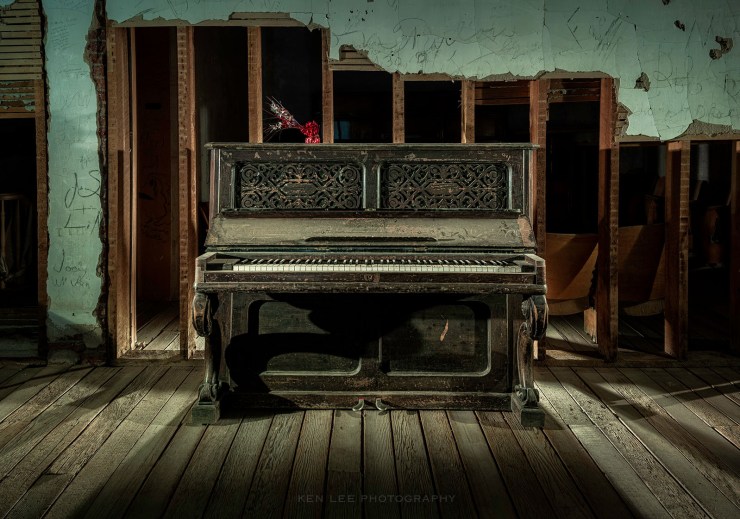Up in the mountains of Nevada is a ghost town. It was a former old Western mining town, and its fortunes rose and fell with the demand for precious metals.
We arrived at the town, ready for some night photography. One of the largest buildings has two stories, both with high ceilings. When I carefully went up the long stairs to the second story, I found this piano there.
I am a musician and play keyboards and guitar. Therefore, whenever I encounter an abandoned piano, I wonder what songs were played, who sung or danced to it, and what symphonies were unfinished. And of course, I always photograph the piano.

Haunting melodies
My two friends were still downstairs. For fun, I began playing a few random high keys. These eerie out-of-tune notes echoed downstairs, drawing an immediate reaction: “Whooooaaaaaaaa!” It was eerie enough that we even created a short video of how the notes sounded downstairs a little later!
Determining how to light the piano
I walked around the piano for a while, shining my flashlight at various angles. Looking around, I noticed the plaster from the wall had given way, exposing the old studs. The handwriting on the old plaster was interesting as well. Since much of the wall was gone, I could walk to the room in back and illuminate from behind.
However, that room had a couple of rows of connected wooden chairs. This posed a bit of an issue since I would have to work around it. I would need to crawl around underneath them to get similar angles. It would be challenging. But I decided it was worth it.
Three steps to illuminating the piano
1. Backlighting the piano
I crawled underneath the connected wooden chairs, extending my handheld ProtoMachines LED2 light painting device to approximate the angle. It was challenging because the chairs were blocking much of the angle. Nevertheless, I managed to get it close.
I then backed up and swept the light from left to right, so that this would create more shadows that would emanate forth on the floor from both the piano and the studs. As a bonus, I briefly illuminated the flowers on the top of the piano.
2. Illuminating the piano from the left side
I walked back into the room and walked to the left of the piano. Making sure I would not inadvertently shine the light into the camera, I grazed the front of the piano to create detail.
3. Illuminating the piano from the right side
I walked to the right side of the piano. Here too, I used an angle relatively close to 90 degrees from the camera. This enabled me to graze the piano to create detail and shadow as well.
Why illuminate from the sides?
Have you ever used the built-in flash of your camera or phone camera to illuminate people or things? What did it look like to you? Probably not very flattering.
Light coming straight on to the subject is often harsh and not very flattering. Many photographers choose to use off-camera flash or bounce the light off a wall or ceiling.
Light painting is no different. You are still using light. However, you simply are applying it more slowly and cumulatively during a long exposure image. This is one of the advantages of light painting. You may illuminate something from multiple angles in one photo, and with different colors and levels or brightness if you wish. But you can do this without having to set up multiple lights on stands or other complex setups and triggering.
Tell your story with the second annual Visual Storytelling Conference!
Experience four days of interactive, online training sessions featuring a range of educational content with experienced photographers and content creators. This free event kicks off with a series of technical boot camps to build essential skills, followed by live, online sessions on photography, video, business and social media. Join live from March 10-13, 2022!
